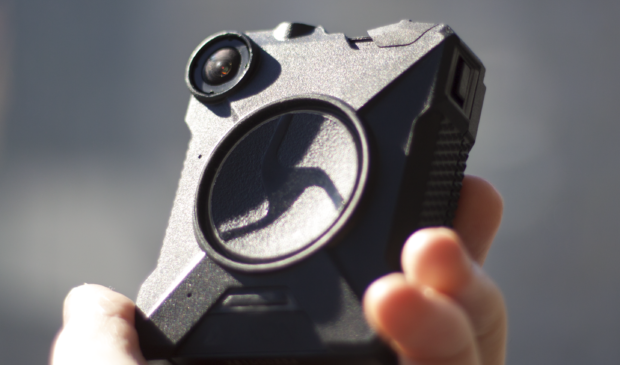Most Austin police officers will soon have body cameras
Tuesday, January 9, 2018 by
Jack Craver It may not be long before every Austin police officer is wearing a body camera.
Since October, the Austin Police Department has equipped officers at three of its four substations with body cameras, Assistant Police Chief Ely Reyes told the Public Safety Commission Monday. The department plans to implement the cameras for officers at the north substation next and plans to have all patrol officers equipped by the end of the first quarter of the year, he added.
While a number of officers downtown have been wearing the devices for years, it wasn’t until June 2016 that City Council approved funding to implement the technology citywide. Implementation was delayed by nearly another year, however, due to a lawsuit challenging how the city awarded the body camera contract.
Shortly after a judge lifted the injunction that had prevented Council from implementing its contract with Axon (formerly Taser International), the firm that won the contract, Council approved funding for 700 body cameras. In December it approved funding for another 1,200, two months after the Texas Supreme Court ruled in the city’s favor, putting a permanent end to the litigation.
While police accountability activists have been pushing for body cameras for years, arguing that they offer critical evidence when assessing allegations of police brutality, many also have concerns about ways the cameras might be abused by police departments.
Chris Harris of Grassroots Leadership, a local group active in pushing criminal justice reform, told the Public Safety Commission that the city’s current body camera policy had many of the same issues as the police union contract that he and other activists convinced Council to reject last month.
The policy states that the body camera footage will be kept for 180 days. That’s the same time limit imposed on the police department to discipline officers for misconduct.
Harris was also concerned about officers being able to review the footage of a critical incident before being interviewed following a critical incident, such as a shooting.
Finally, he said the policy needed greater assurances that the body cameras will not be used for mass surveillance, including through the use of facial-recognition technology, which he suggested could become commonplace “not that far in the future.”
Matt Simpson of the American Civil Liberties Union of Texas echoed some of Harris’ concerns but largely applauded the current policy, blaming much of its shortcomings on state law, which bars police departments from releasing footage of “critical incidents” unless there is a “law enforcement purpose.”
To request footage of an event that is not barred from release by state law, an individual must fill out a form that includes a date, time of day, location and name of a subject involved. Commission Chair Rebecca Webber noted that she had made a couple of requests and had had one sent back to her due to a failure to include one of those pieces of information.
Simpson was happy to note that the current policy includes a provision that allows citizens to request that officers turn their cameras off. He framed that provision as one that could allow those concerned about privacy to interact more comfortably with a police officer.
Simpson said APD should continually engage with the community over the body camera issue and keep updating its policy to reflect major concerns as they arise.
In an interview with the Austin Monitor, Simpson said that he believes that the police may have felt the need to put in place stricter release rules out of concerns that people were going to be regularly requesting massive amounts of footage. That has not been the case, he said, and the police are increasingly recognizing that.
“It just hasn’t been onerous,” he said.
This story has been corrected. We originally reported that the lawsuit against the city was ongoing. Texas Supreme Court ruled in the city’s favor last year.
photos courtesy of Axon, Scottsdale, AZ, USA.
The Austin Monitor’s work is made possible by donations from the community. Though our reporting covers donors from time to time, we are careful to keep business and editorial efforts separate while maintaining transparency. A complete list of donors is available here, and our code of ethics is explained here.
You're a community leader
And we’re honored you look to us for serious, in-depth news. You know a strong community needs local and dedicated watchdog reporting. We’re here for you and that won’t change. Now will you take the powerful next step and support our nonprofit news organization?











